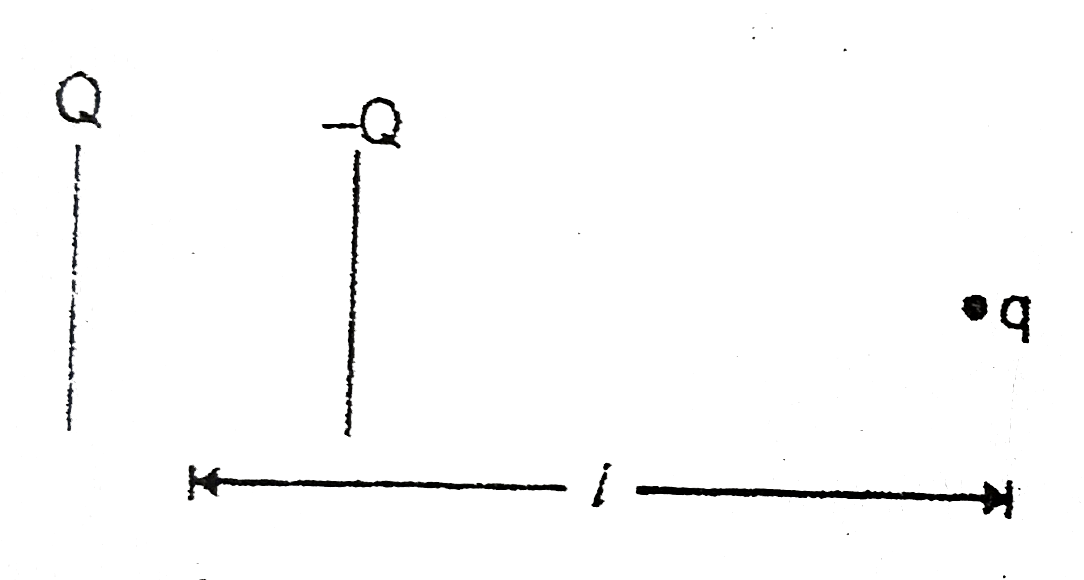The nagative plate of a parallel plate capacitor is given a charge of −20X10−8C. Find the charges appearing on the four surface of the capacitor plates.

Let the charge appearing on the inner surface of the nagative plate be -Q. The charge on its outer surface will be <br> Q - 20 X 10 ^(-8) C<br>. The charge on the inner surface of the positive plate will be + Q from Gauss's law and that on the outer surface will be -Q as the positive plate is electrically neutral. The distribution is shown in figure. To obtain the value of Q, consider the electric field at a point P inside the upper plate. Field due to suface (1) <br>= (Q)/(2 epsilon_0 A)<br> upward, due to surface (2) <br>=(Q)/(2epsilon_0 A)<br> upward, due ot surface (3) <br>= (Q)/(2 epsilon_0 A)<br> downward and due to surface (4) <br>= (Q - 20 X10^(-C)/(2epsilon_0 A)<br> upward. As P is a point inside the conductor, the field here must be zero. Thus, <br> Q = - Q +20 X10^(-8)<br> C. or Q = 10 X 10^(-8)<br>C. The charges on the four surfaces may be written immediately from figure.

Topper's Solved these Questions
- CAPACITORSBOOK - HC VERMA ENGLISHCHAPTER - CAPACITORSEXERCISE - Objective 1
12 Videos
- CAPACITORSBOOK - HC VERMA ENGLISHCHAPTER - CAPACITORSEXERCISE - OBJECTIVE 2
6 Videos
- CAPACITORSBOOK - HC VERMA ENGLISHCHAPTER - CAPACITORSEXERCISE - short answer
7 Videos
- BOHR'S MODEL AND PHYSICS OF THE ATOMBOOK - HC VERMA ENGLISHCHAPTER - BOHR'S MODEL AND PHYSICS OF THE ATOMEXERCISE - Short Answer
10 Videos
- DISPERSION AND SPECTRABOOK - HC VERMA ENGLISHCHAPTER - DISPERSION AND SPECTRAEXERCISE - Question for short Answer
6 Videos
Similar Questions
Knowledge Check
As the distance between the plates of a parallel plate capacitor decreased
AIf both assertion and reason are ture and reason is the correct explanation of assertion.BIf both assertin and reason are ture but reason is not the correct explanation of assertion .CIf assertion is true but reason is false.DIf both assertion and reason are false.
For the system shown in capacitance is C The left plate is given a charge Q1 and the switch is closed.
 .
.
Find the charge appearing on the inner face of the left plate.
View SolutionA parallel plate capacitor is charged. If the plates are pulled apart
View SolutionEach plate of a parallel plate capacitor has a charge q on it. The capacitor is now connected to a battery. Now,
View SolutionThe plates of small size of a parallel plate capacitor are charged as shown. The force on the charged particle of 'q' at a distance 'l' from the capacitor is : (Assume that the distance between the plates is d<<l)

View SolutionThe plates of small size of a parallel plate capacitor are charged as shown. The force on the charged particle of 'q' at a distance 'l' from the capacitor is : (Assume that the distance between the plates is d<<l)

View SolutionThree identical metal plates with large surface areas are kept parallel to each as shown in figure (30-E8). The leftmost plate is given a charge Q, the rightmost a chrgear2Q and the middle one remains neutral. Find the charge appearing on the outer surface of the rightmost plate.

View SolutionThe capacitance of a parallel plate capacitor is 2μF and the charge on its positive plate is 2μC. If the charge on its plates is doubled, the capacitance of the capacitor
View Solution

